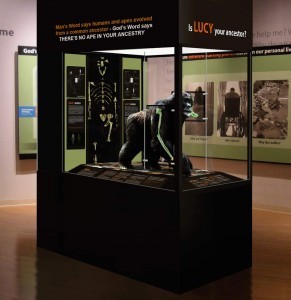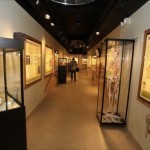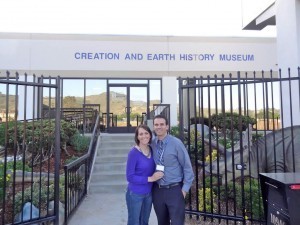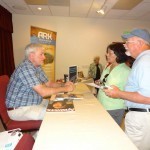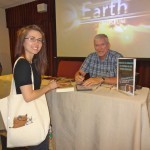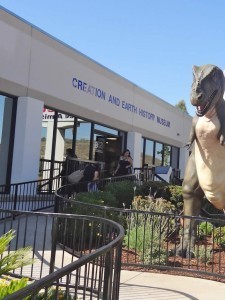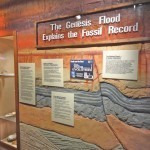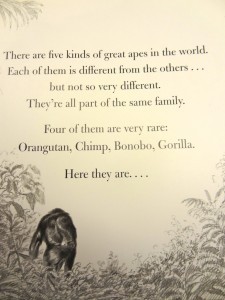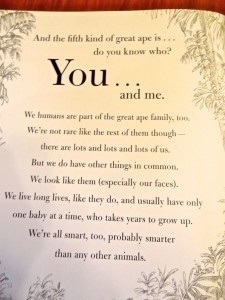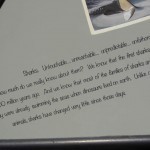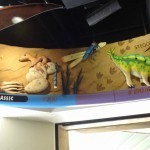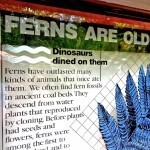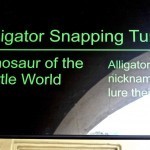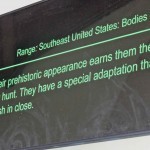Ken Ham's Blog, page 414
May 26, 2012
Warning: “Inerrancy” Means We Can’t Trust the Bible
Thanks to AiG researcher Steve Golden for researching this information and coauthoring this blog post with me.
What a mess the church is in!
It’s important from time to time to examine the views of those who try to harmonize evolutionary ideas with God’s Word. We must understand how those of us who trust the Bible’s account of history should respond to them. Part of our mission is to warn the church about those who are undermining the authority of the Word of God.
Scot McKnight recently published an article series on the BioLogos website. He is a professor of religious studies at North Park University in Chicago. Before that, he was professor at Trinity Evangelical Divinity School in Deerfield, Illinois, where he also earned his master’s degree.
Dr. McKnight was a speaker at the recent Biologos Theology of Celebration workshop held in New York City, and this article series is the printed version of his lecture. Tim Keller and John Ortberg also spoke at the conference. Additionally, Dr. McKnight has been invited to speak at the upcoming Pastorum Live conference, put on by Logos Bible Software.
Dr. McKnight blatantly denies the historical trustworthiness of Genesis. In fact, his denial of biblical inerrancy is more blatant than we usually see from the BioLogos crowd. He writes, “Many Christians grow up with a view of Scripture that it is inerrant, and that means for them … that it is not only true but that is more or less magically true—true beyond its time, true when everything else says something else.”
Before I discuss this statement, I wanted to share another statement from Dr. McKnight regarding the “plain reading” of Scripture:
Connected to this view of inerrancy is a view of Bible reading that takes a sound Christian idea called the perspicuity of Scripture, that the Bible’s message is clear to any able-minded Bible reader, and ratchets it up one notch so that the Bible reader thinks whatever I see in the Bible is what the Bible is saying.
If you as a Christian believe the Bible is inerrant, you’re saying it is without error. And as a creationist, I read the Bible plainly, trusting that I can believe and understand what I read. It’s unreasonable to say that inerrancy and a plain reading of Scripture leads Christians to believe falsehoods as though they are “magically true.” But what is Dr. McKnight referring to specifically here? He writes, “One of which views is that the Bible teaches science in Genesis 1–2.”
Dr. McKnight has not approached Scripture believing it to be inerrant. He has a bias of millions of years and molecules-to-man evolution, and he wants to make the Bible fit into that bias by changing the meaning of inerrancy! Either the Bible is without error or it isn’t. Who are we to pick and choose which parts of God’s Word are true? Those who attempt to do this are basically placing themselves above the Lord as if they get to decide what is truth.
But Dr. McKnight doesn’t stop at the Creation Week. He also accepts that there was death before the Fall, and he presents it as a biblical symbol! He writes, “My life has not permitted me to chase that one very deep into the tohu va-bohu but I do wonder if the ongoing cycle of life and death over millions of years, red in tooth and claw, is not a sacrament of resurrection and of God as giver and restorer of life—in an ongoing sacramental cycle.”
Dr. McKnight’s belief that death before the Fall is a symbol for God giving and restoring life runs counter to the Apostle Paul’s entire message in Romans 5: “Therefore, just as through one man sin entered the world, and death through sin, and thus death spread to all men, because all sinned” (v. 12). The Apostle Paul certainly believed that death came with a literal Fall. Would Dr. McKnight argue that the Apostle Paul was so attached to inerrancy that he believed this to be “magically true”? Further, since God inspired Paul to write these words, would the Holy Spirit believe this to be “magically true”?
In fact, it seems that Dr. McKnight would also have to say that the Apostle Paul’s belief in Adam and Eve’s existence is a “magical” belief. McKnight writes, “In other words, if the common hypothesis [is] that our DNA owes to more than two people, the original couple, Adam and Eve, then maybe we have been reading ‘Adam’ wrong for a long, long time. In other words, what if Adam and Eve are understood more in archetypal terms, as we find in the work of John Walton.”
At this point, Dr. McKnight begins a game of turning major biblical characters and accounts (e.g., Jonah and the fish) into symbolic myths in order to prove his point—there was supposedly no historical Adam.
The Apostle Paul clearly believed Adam was real, as he indicates when he writes that it was through “one man” that sin entered the world and that Christ was the “last Adam” (Romans 5:12; 1 Corinthians 15:45). But Dr. McKnight has this argument covered! He says Christians may try to claim that denying some parts of Scripture requires a denial of the rest, but, he writes, “Slippery slope arguments don’t work for me.”
Dr. McKnight’s response to this argument and to the inerrancy of Scripture reminds me of 2 Peter 3:5, where Peter says that in the last days, people will make themselves “willfully ignorant” of biblical truths, particularly regarding Creation, the Flood, and the return of Christ. That’s exactly what we see happening—in the church!
Scripture clearly indicates that Adam was real and that there was a literal creation and a literal Fall—there’s no doubt when one reads the text plainly. But man’s pagan religion of millions of years and evolutionary beliefs requires these compromisers to change meanings of words, to deny that the text really says what it does, and to claim that God cannot be fully trusted in the face of the “scientific facts” surrounding evolutionary claims.
Just what was Dr. McKnight’s point in speaking at the BioLogos conference and in publishing this series? He closed the article with a call for pastors, seminary professors, and other Christian leaders to participate in the BioLogos grant program, which seeks to reconcile the Bible with evolutionary ideas. I previously wrote a blog post on this on this topic.
A big part of AiG’s mission is to call the church out of compromise and back to the authority of the Word of God.
How sad it is that Logos Bible Software would use such a compromiser of God’s Word in their conference!
Thanks for stopping by and thanks for praying,
Ken

May 25, 2012
All Museum Tickets Now Valid for Two Days!
As of today, all tickets purchased for Creation Museum entrance will be valid for two days! Here is yet another reason to include a visit to the Creation Museum as a part of your summer plans.
The museum has already established its reputation as a family-friendly location with much to see and do. In recent years, we have been offering guests the opportunity to visit the museum for two days and receive a discount for the second day by purchasing a two-day ticket . You see, many guests were telling us that there is too much to do at the Creation Museum in one day, so we decided to offer a two-day discounted pass. That idea has gotten even better. As of today, we’ll now be offering more value to our visitors: any ticket purchased for admittance to the Creation Museum is good for two consecutive days!
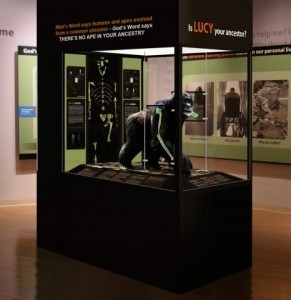
Lucy Exhibit
Since opening in 2007, we have added significant exhibits every few months—even a petting zoo. Thus many of our guests have wanted to spend two days here. Last month, for example, we opened the Johnson Observatory with some excellent telescopes (viewings held on some select evenings). And this Saturday morning, we will open a brand-new, high-tech exhibit on “Lucy,” which evolutionists use as perhaps their best example of how humans evolved from an ape-like ancestor. It’s a stunning exhibit! You really need to see how we have used holographic technology to show museum guests that Lucy is no such “missing link.”
To show you how the museum can be a two-day destination, here is comment from a homeschooling mom who toured the museum with her family recently (slightly edited):
I highly recommend two days when touring the Creation Museum with kids. We were able to space out the main museum walk through the Seven C’s and the other fun things we wanted to do, like hiking through the gardens and watching the planetarium show. It would have been impossible to fit everything we wanted to do into a single day without turning our experience into an over-managed-child-frustrating-mother-crazifying nightmare.
Two Days = A must for families. This way we could let each of our children enjoy something that was of interest to them without rushing them through the experiences.
(http://www.untrainedhousewife.com/visiting-the-creation-museum-with-a-family)
Also, as a way to further lower the cost to families who are excited about the possibility of visiting the Creation Museum, a $5 discount, starting after June 3, is being offered to any adult ticket that is initially purchased for use on a Tuesday or Wednesday and then used the next day. (That $5 discount is only available while on-site and not through the web.)
By the way, did you know that a highly popular U.S. travel book produced by Lonely Planet (based in Australia) has picked our Cincinnati area as one of the “top 10 U.S. travel destinations for 2012.” It describes Cincinnati as the “pretty city on the Ohio River”—a city that has “transformed itself in the last decade into a worthy weekend getaway.”
There are many other great attractions in the region. For example, Dayton (which is north of Cincinnati) contains the largest Air Force Museum in the world, as a walk through the history of flight and the history of World Wars 1 and 2 and the Space Age—and it’s free! Also near us are the Cincinnati Zoo, the Newport Aquarium, the Underground Railroad Museum (about the slave trade), and much more. So make Cincinnati the destination for your vacation.
Go to creationmuseum.org for more information.
Thanks for stopping by and thanks for praying,
Ken

May 24, 2012
Legacy Five in Legacy Hall
As many of you know, we’re celebrating the Creation Museum’s fifth anniversary this weekend. One event that I’m looking forward to is the Legacy Five concert in our new auditorium, Legacy Hall, on Saturday evening at 7:00 p.m.
Recognized by the Southern Gospel Music Association with several awards, including “Recording of the Year,” Legacy Five will bless your family as you enjoy hearing the good news in four-part harmony!

Legacy Five
I’m constantly hearing great comments from museum guests about the tremendous value that the Creation Museum offers for families. This special event will be no different. Tickets to the concert are only $5, and as an added benefit, members of the group will be in the Legacy Hall lobby at 6:00 p.m. to meet you.
You can reserve your tickets by calling our Customer Service number at (800) 778-3390. You may also purchase your tickets at the museum ticket counter.
For more information, see the following:
Museum Anniversary blog post
Legacy Five Creation Museum blog post
Legacy Five website
Other Happenings at the Creation Museum
The high-tech Lucy exhibit is being installed and will be unveiled for the public beginning this Saturday morning. Installers are working hard as they set up this unique and powerful new exhibit addition to the Creation Museum (see photo below).
This year we added the popular Bruster’s Real Ice Cream beside the Creation Museum new coffee shop. Bruster’s is proving to be very popular with their ice-cream, sundaes, shakes, and more. Here are some photos of Bruster’s:
See you soon at the Creation Museum! Hopefully many of you can come this weekend as we reach the five-year milestone for this one-of-a-kind, evangelistic museum.
Thanks for stopping by and thanks for praying,
Ken

May 23, 2012
Creation Points to the Cross and Consummation
Many people are pleasantly surprised when they come to the Creation Museum and realize that this facility and its exhibits are not just about creation vs. evolution and age of earth issues, but portray the message of the whole Bible from the beginning to the end. As I have often said, we don’t want to just convert people to be creationists as a creationist can end up separated from God for eternity like an atheist! We need to see people converted to Christ! Certainly in this day and age, there has been a very focused attack on the first eleven chapters of the Bible in a spiritual war for the hearts and minds people. Many of the coming generations have been led to doubt the first eleven chapters, and this has put them on a slippery slide of doubt and unbelief through the rest of Scripture.
Thus the ministry of AiG and the Creation Museum, in its presentation of the Word of God and the gospel, have specialized in creation and general biblical apologetics (giving people answers to skeptical questions and so on) to deal with this attack on Scripture in this era of history. And through all that, we make no apology about the fact, and we are not ashamed at all, that our primary purpose is to present the gospel of Jesus Christ and see people saved to be in heaven for eternity.
Recently, AiG staff member Steve Ham reminded the staff of this in a devotion at an AiG staff chapel time.
As many of you are aware, the Creation Museum explains world history through the use of the Seven C’s of History: Creation, Corruption, Catastrophe, Confusion, Christ, Cross, and Consummation. The purpose of the Seven C’s is to first establish the bad news in Genesis, so that people might have a proper understanding of the good news (gospel). Steve Ham, at Answers in Genesis, taught on 1 John 2 in a recent staff meeting. In his teaching, he made the point that as we teach the history of the Bible according to the Seven C’s, we must understand the importance of the message of all the C’s as a united whole.
In our ministry distinctive, it is vitally important we support the local church in helping the body of Christ defend against the major attacks from the world that are pointed at the first four C’s. That importance is increased when we realize the first four C’s provide the historical foundation to understanding Christian doctrine and the Bible. Yet, in doing this vitally important job, biblical creationists must also keep in mind the unified message of the Seven C’s. Steve made the point that if we speak of the first four C’s alone, we are in danger of not pointing people to Christ. If we speak only of the first six C’s, we are in danger of not pointing to the hope that is in Christ in the seventh C, as He brings in the consummation of all things and a new heaven and earth.
All Seven C’s are also essential for the fullness of a biblical Christian worldview. The first four C’s help us to understand the world we live in. It is because of the last three C’s that we can live in it with victory and hope for the future. The point of the message is that whenever we are dealing with any individual portion of biblical history, it is important to understand that each individual account is a part of the whole divine message.
This perspective helps us understand the importance of what we are doing in the ministry of Answers in Genesis. We must defend the historical accuracy of the first eleven chapters in Genesis because in doing so we are pointing to the credibility of our Savior and our need for him. We are also pointing to a full resolution to all the problems in this physical creation caused by sin as we acknowledge that God is going to make all things eternally new. The Seven C’s as a whole tell us two great truths: Because of man’s corruption, we live in a cursed world where man (on his own) fails in every sense; but because of Christ, we can live in victory with full hope of a never-ending glory.
There is an interesting parallel between Creation and the other C’s. Essentially, Adam and Eve were presented with the best of conditions and could not pass the test. However, Christ was under the worst of conditions, yet he passed the test. Dr. Russell Moore, dean of the School of Theology and senior vice-president for Academic Administration at the Southern Baptist Theological Seminary, explains this same parallel further in his book Tempted and Tried: Temptation and the Triumph of Christ (Wheaton, Illinois: Crossway, 2011). He writes the following (concerning the tempting of Christ in the wilderness):
We’ve already seen what the satanic powers have done to lure away humanity in general from God’s reign. That’s our universal human story. Jesus reorders human desire by joining the race as a desiring human being. … As he stood where Adam stood, he reclaimed what Adam lost. The first Adam was tested in the God-blessed garden and fell. The second Adam was tested in the God-cursed desert, and won. (p. 41)
The importance of Christ’s temptation as it relates to man’s fallen state is staggering. Moore lays out the primary difference between man and Christ in their respective temptations as this: Christ’s desires mirror those of His Father. While Adam fell when he shifted his desires to earthly things, Christ overcame temptation in the wilderness, and by His death and Resurrection alone are we saved. At the Creation Museum, we show a film called The Last Adam for all of our visitors, and it makes the same point: we can trust Christ for our future because “He is also able to save to the uttermost those who come to God through Him, since He always lives to make intercession for them” (Hebrews 7:25).
The essence of Steve’s message focused on the seventh C—Consummation. We are living in the last days (1 John 2:18), and Christ will return. Knowing that He has won the victory over sin—the battle humanity lost, even in a perfect world—let’s look with eager anticipation toward the Lord’s return because He alone is our hope.
I believe you will be greatly blessed when you visit the Creation Museum—and bring your non-Christian friends and family. It is a great place to present the gospel to the unsaved in an non-threatening environment. The presentation of the Word of God and the gospel is done in a very tasteful but authoritative way.
Thanks for stopping by and thanks for praying,
Ken

May 22, 2012
A Pastor’s Response
We have seen many pastors visit Answers in Genesis and the Creation Museum. I thought you would all be encouraged to know how these influential pastors respond to the AiG ministry and Creation Museum.
Yesterday, we were thrilled to host Pastor Michael Lewis, senior pastor of First Baptist Church of Plant City in Florida. Pastor Lewis was accompanied by his wife Lilliana and his four delightful daughters Faith, Hope, Charity, and Joy.
Pastor Lewis spoke at an AiG staff chapel, and then I had the privilege of showing them through the Creation Museum, AiG offices, and our facility housing the Ark Encounter project staff. What a blessing to interact with this family. Their four daughters were such as blessing as they soaked in all they saw and heard, and shared their heart to witness to others for the Lord Jesus. Here is what Pastor Lewis wrote to us after the visit:
My wife, four daughters and I had an incredible visit at the Creation Museum this week in Petersburg, Kentucky. The morning began with a chapel service which I was privileged to share from Joshua Chapter 1. The staff was very receptive and appreciative for the preaching of God’s Word … Ken Ham, President/CEO of Answers in Genesis and The Creation Museum, guided our family on a tour of the faith enriching museum which he envisioned and designed.

Ken Ham with the Lewis family
Our hearts burned within us as the Bible was displayed in 3-D before our eyes from creation of the world to the corruption of sin, from corruption to the catastrophe of the worldwide flood, from the catastrophe to the confusion of the tower of Babel, from the confusion to Christ and His cross. Ken Ham gave to us a behind the scenes tour of the Answers in Genesis studios and the new Ark Encounter. Dr. Ham has envisioned a full- size Noah’s Ark with a Biblical theme park which will be used evangelistically to engage a post-modern culture with the truth of the Gospel. Jason Nave, [AiG staff member] was a gracious host giving to our family … a V.I.P. treatment.
Here is a photograph of the Lewis family and me taken in front of the mock up of one of the exhibit sections that will be within the Ark (96 such exhibit sections will exist in the Ark):
Pastor Lewis continued, “The Creation Museum is a must see for anyone sincerely pursuing the truth of science, for it places you face to face with the reality of the Creator. Parents will want your children exposed to the amazing presentation of God’s Word which is absent in much of educational circles today.”
Pastor Lewis describe the Noah’s Ark project as a “captivating vision” and stated, “this amazing project … I believe will bring many to faith in the Lord Jesus.”
New Lucy Exhibit Open Saturday
The new high tech Lucy exhibit will be ready for Creation Museum visitors to see beginning this Saturday. Installation is well under way. Here is an artist’s mock up of what part of the exhibit will look like:
Thanks for stopping by and thanks for praying,
Ken

May 21, 2012
A New Translation to Allow for Evolution and Millions of Years?
Every so often, new translations of the Bible are released because some people think they’ve found a better way to translate it or because they want to make it easier to read. Well, recently, Thomas Nelson and the Ecclesia Bible Society released their translation of the entire Bible, called The Voice. (The New Testament was released in 2011, and the compiled Old and New Testament was released this month.) The team who did the translation describes The Voice this way:
The Voice is a dynamic equivalent translation that reads like a story with all of the truth and wisdom of God’s Word. Through compelling narratives, poetry, and teaching it invites readers to enter into the whole story of God with their heart, soul, and mind. This bold new translation engages readers like no other Bible. (http://www.hearthevoice.com/about-the-translation)
The Voice actually looks and reads like a script to a play, with short bits of commentary on how certain characters—including God—are reacting. Unfortunately, a literal translation of the words of Scripture does not always support these bits of commentary.
The team of writers and researchers on this translation included Tremper Longman, a Bible scholar who regularly voices doubts about the historical trustworthiness of Genesis. Longman has said that the creation account in Genesis does not conflict with evolutionary ideas (http://www.youtube.com/watch?v=I8Pk1vXL1WE).
A couple of our researchers examined just the first two chapters of the Bible (Genesis 1 and 2) in The Voice to see if the translation stayed true to the original text. They found some commendable parts of the translation, but they also found a number of areas of concern. It’s important to note that the following report contains only some of the problems with the translation.
1. Genesis 1:9 reads, “Let the waters below the heavens be collected into one place and congregate into one vast sea, so that dry land may appear.”
The italicized portion does not appear in the original Genesis manuscript. The problem with this addition is really one of logic: if the waters already cover the whole earth, they are already congregated into “one vast sea.”
2. “Evening gave way to morning.”
This phrase appears in place of the more common, “And there was evening and there was morning.” While we recognize that the phrasing chosen in The Voice was likely for literary reasons (i.e., making the text more readable), the wording is less than precise. If we’re being faithful with the text, then the language should clearly point to literal, 24-hour days. The Voice’s phrasing allows room for interpretation when it comes to the length of each day of creation.
3. Genesis 1:14–16 reads, “God: Lights, come out! Shine in the vast expanse of heavens’ sky dividing day from night to mark the seasons, days, and years. Lights, warm the earth with your light. It happened just as God said. God fashioned the two great lights … ”
While the verses following would imply that God went on to “fashion” the sun and the moon, the wording leaves open the possibility that the two great lights were already there and that God simply cultivated them. This would be consistent with the first verses of Genesis as The Voice renders them: “In the beginning, God created everything: the heavens above and the earth below. Here’s what happened: At first the earth lacked shape and was totally empty, and a dark fog draped over the deep … ”
The sun and the moon were created on Day Four. They were not simply brought out to shine. Those who compromise on Genesis by mixing the Big Bang and billions of years with the Bible claim that God somehow cultivated what was already in existence, rather than actually creating (for instance, see the writings of a well-known progressive creationist, Hugh Ross, who believes in a Big Bang, billions of years, local Flood instead of global Flood, and a race of soulless people before Adam and Eve).
4. Genesis 1:21, 25 reads, “So God created huge sea creatures, all the swarm of life in the waters, and every kind and species of flying birds … God made earth-creatures in a vast variety of species …”
The problem with these verses is that the authors are equivocating on the word species. What is an equivocation? An equivocation occurs when someone uses a word and then adjusts its meaning slightly in the course of the discussion. For example, if someone says, “Evolution is a scientific fact. The evolution of bacteria becoming resistant is well-documented.” Evolution in the first statement refers to molecules-to-man evolution, while evolution in the second statement refers to general “change.” These two definitions are very different and cannot be confused with one another in the course of a discussion. (Jason Lisle, Discerning Truth, Green Forest, Arkansas: Master Books, 2010.)
In the use of the words kind and species, the authors seem to be equivocating on the latter. They first imply that “kinds” and “species” are the same, and then they switch to using species. What’s the problem? Creationists are sometimes accused of promoting the fixity of species, meaning that God created every single possible variation of each animal during the Creation Week. But most creationists do not believe in the fixity of species; we believe that God created animal kinds and that these animal kinds had all the genetic material within them to reproduce into the many variations we see today. These variations would be closer to species than kinds.
The wording here also has bearing on the Ark. Scripture clearly says that Noah took animals aboard according to their “kinds” (Genesis 7:14). Noah probably could not have fit every single species of animal on the Ark. But creationist researchers have found that if Noah took animal kinds on the Ark, he would have had no problem fitting them all. Researcher John Woodmorappe, in Noah’s Ark: A Feasibility Study (Dallas, Texas: ICR Publications, 2009) found that, at most, there were approximately 8,000 animal kinds (or 16,000 individuals) on board. Researcher Arthur J. Jones, in “How Many Animals in the Ark?” (Creation Research Society Quarterly 10, no. 2, September 1973) found that, at minimum, there were 1,000 animal kinds (or 2,000–3000 individuals—there were seven of some kinds) on board the Ark. Remember, Noah did not need to bring insects or any of the water-dwelling creatures on board either, so that would significantly reduce the amount of required animals the skeptic usually mentions.
5. Genesis 1:31 reads, “Then God surveyed everything He had made, savoring its beauty and appreciating its goodness.”
Once again, we recognize that the wording in this verse is likely for literary reasons, but it is imprecise. Opponents of young earth creationism often try to argue that there was death in the world before the fall, and death is not a “good” or “beautiful” thing. This verse’s wording leaves open the possibility that there were bad things in the world at this point, but that God was simply “savoring” only the good parts. The more common rendering prevents this kind of reinterpretation: “God saw all that He had made, and behold, it was very good.”
6. Genesis 2:4 reads, “This is the detailed story of the Eternal God’s singular work in creating all that exists.”
We were very happy to see the emphasis placed on the fact that Genesis 2 is simply a more detailed version of part of Genesis 1. But the problem with this verse lies in the next word: story. With so many people, Christians and non-Christians alike, trying to argue that the creation account in Genesis is a myth, the word story does not help make the case that Genesis is historical. Once again, this is an issue of precision with the translation, and the more common word, account, would have been the better choice here.
7. Genesis 2:4–5 reads, “On the day the heavens and earth were created, there were no plants or vegetation to cover the earth. The fields were barren and empty, because the Eternal God had not sent the rains to nourish the soil or anyone to tend it.”
These verses are one of the primary points of debate between young-earth creationists and those who disagree. Opponents of young-earth creationism will argue that there is a contradiction in Genesis 2 because the plants were created on Day Three in Genesis 1.
Several solutions to this apparent dilemma have been proposed. One view points out that the Hebrew words used for “plants” and “vegetation” are actually very specific words meaning “wild shrubs of the steppe” and “cultivated grain.” Tim Chaffey’s article “Planting Confusion” addresses these translation issues in more depth. Suffice it to say, there is no contradiction. The text indicates that only certain plants were not yet growing because man was not there to cultivate them. God still created the plants described in Genesis 1 on Day Three of the Creation Week.
8. In the additional commentary the authors added between Genesis 2:17 and 18, shortly after God commands Adam not to eat of the tree of the knowledge of good and evil, the authors write, “After God gives man this directive, He realizes something is missing.” That something is Eve.
The simple answer to our problem with this passage is that it’s simply wrong. Our God is omniscient, or all knowing, so the possibility that He could “realize” something, as though He didn’t know it before is impossible (Psalm 147:5). The more likely explanation for God’s statement—“It is not good for the man to be alone”—in Genesis 2:18 is that He was making a statement of fact. Based on God’s omniscience, we can say that He intended to give Adam a companion from the beginning.
Sometimes Bible translations that have a high degree of dynamic equivalence can be useful to read in order to give an overview of what Scripture is saying, but to ensure one understands it correctly and does not misunderstand an important doctrine, one needs to carefully study a literal translation. This particular translation appears to us to be written to allow for millions of years and evolution—but without saying so. Knowing that at least one of the researchers doesn’t see a conflict between Genesis and evolution certainly supports this.
The above seems to us to be another example of how evolutionary ideas and millions of years are influencing the church.
I want to acknowledge the research assistance of Steve Golden and others at AiG in the preparation of this blog post.
Thanks for stopping by and thanks for praying,
Ken

May 20, 2012
Creation and Earth History Museum—Southern California
A number of years ago, the Institute for Creation Research was located in Santee, California (east of San Diego). They built a small but very good Creation and Earth History Museum based on a literal understanding of the book of Genesis. When ICR sold their buildings and moved the organization out of state, their buildings were purchased by a biotech company owned by a Christian businessmen who is an ardent creationist—and a good friend and supporter of AiG—Tom Cantor.
Tom and his wife Cheryl wanted to not only keep this museum going but also enhance and expand it. For instance, AiG’s Dr. David Menton came out to California to help them with a special detailed anatomy exhibit that was opened recently:
Tom appointed Jayson Payne to be the full-time museum director. The biotech company funds the museum so it can be free to the public. Here is a photograph of Jayson and his wife Erika at the front of the museum:
Jayson and Erika came out to our Creation Museum in Kentucky recently so he could gain ideas and advice and to continue cementing the great relationship we have with those involved in this museum in southern California. While I was in San Diego for a few days of vacation, I was privileged to do a meet and greet/book signing at this facility. It was great to meet a stream of visitors who came for that special time this past Thursday afternoon:
As you walk to the front of the building you will see a T. rex:
And then you see this special dedication plaque:
Here are a few photos taken in various parts of the museum:
I know it is somewhat difficult for people in California to visit the Creation Museum (we are near Cincinnati), so until that time, I would encourage you to visit the Creation and Earth History Museum in Santee, California. And if you are visiting San Diego for any reason (it’s a great vacation spot, including in the winter), I encourage you to make this a place to visit.
Tom and Jayson continue to expand this museum; they are working on an “Age of Earth” exhibit and also a model of the Old Testament Tabernacle for the future.
You can do a virtual tour of the museum at this link.
The museum is open Monday to Saturday, 9 AM–6 PM.
You can find out more about this museum at http://creationsd.org/.
Thanks for stopping by and thanks for praying,
Ken

May 19, 2012
You Are an Ape!
How would you like to have someone tell your children that they “are an ape”—that they are just an animal?
My wife and I—and our daughter—spent part of Thursday at the San Diego Zoo. As we were looking through the gift store just before we left, I came across this book they were selling:
I opened to the Introductory statement that said:
So then I went through the pages to see these “five kinds of great apes.”
First:
Then:
And then:
Then I was intrigued—so what will the fifth one be?
I opened the page and read:
So we humans are the fifth apes—and there are lots and lots of us. The book then goes on to say:
I thought of a number of things (and there are many more I could discuss) as I pondered this:
1. There are “lots and lots” of apes we call humans—I guess that’s why we can abort millions of babies—there are so many of us. But there aren’t that many of the other apes, so we need to look after them.
2. There were hundreds and hundreds of elementary age school kids at the San Diego Zoo the day we visited. I wonder what the parents of these kids would think if the teachers started calling the kids “apes.” Something like: “Ok you apes, do what I tell you to do.”
3. I wonder what would happen if kids took off their clothes and said, “We are only apes, and apes don’t have clothes, so why should we have clothes?”
4. Maybe the teachers should tell these supposed “apes” (children) to sit on the ground and then throw food to them—as a person would do for an animal at a zoo. But we don’t do that because, as the book says, we are “smart apes” (i.e., we are more evolved!). However, the book says that we are “probably smarter than any other animals,” so we may not really be that smart after all! Hard to believe a world-class zoo would sell such nonsense to parents and kids!
5. It was interesting, as we were on the bus tour, the zoo tour guide kept telling the children to be quiet for the animals’ sake! Wait a minute! Didn’t she read this book that the zoo—the facility that employs her—sells? Those kids are just apes—they are animals, too. Why should she tell them to be different to the animals in the pens and cages? I never saw her telling the chimps to be quiet when they were making a racket.
The mind boggles. We could continue down this ape/people line in many ways covering topics of sex, old age, etc. etc.
But—this is where the world is at today. And if the San Diego Zoo is selling this book, they must approve of its contents. Shame on the San Diego Zoo (one of the world’s leading zoos) for promoting the false idea that we are just another ape—and we are “probably smarter than any other animals.”
It’s just another reason why you need to bring your family to the Creation Museum this summer. We tell kids the truth—they are made in the Image of God—and thus they are very special. And even though they sinned in Adam, their Creator God paid the penalty for their sin and offers them a free gift of Salvation! What a different message we give them.
Thanks for stopping by and thanks for praying,
Ken

May 18, 2012
The “Disease” Is Everywhere
Recently I have written a number of articles about the fact that even though we know sin is the ultimate “disease problem” in this world, I liken the teaching of millions of years to a disease and the teaching of evolution to be a symptom of the disease.
I say this because most of the questions I get from the secular media concern the age of the earth or why we believe dinosaurs lived with people—not so much about evolution. I have found that if a Christian doesn’t believe in evolution, then the secularists will scoff a bit, but if a Christian rejects millions of years, then secularists really go ballistic. They will call you anti-academic, anti-science, anti-intellectual, etc. This happens because millions of years is really the religion of this age used to justify explaining life without God.
You see, without millions of years, the secularists can’t propose molecules-to-man evolution. As one Nobel prize-winner, George Wald, said, “Time is the hero of the plot.” The secularists put time and death together—time and death over millions of years to evolve the life forms we see today (including man). The Bible puts sin and death together—it was man’s sin that brought death into this world.
Sadly, because the secular world so intimidates people to believe in millions of years, many Christians have adopted this pagan religion of the day and compromised God’s Word, thus undermining the authority of Scripture.
I have noticed that in museums, zoos, documentaries on television, and many other places, people will see millions of years promoted much more than evolution. Millions of years just permeates the culture. No wonder so many people (including many Christians) think they have to believe in evolution.
I was reminded of this recently during a short vacation trip to southern California with one of our daughters.
For instance, at the Shark Encounter exhibit at Sea World in San Diego, one reads a sign stating millions of years:
At the Jurassic Park ride at Universal Studios, we see a timeline of the supposed millions of years for dinosaurs:
And we see this sign at Universal Studios outside the Jurassic Park ride gift store:
We need to be reminded that from a biblical perspective, there is no such thing as “prehistoric,” as history began from when it was recorded.
At California World (another park associated with Disneyland, California), in the 4D bug program (a very entertaining program), it begins with a bug stating, “We have been around for 300 million years.”
And then the train at Disneyland takes visitors on a ride through the supposed “age of dinosaurs”:
And then there is the subtle indoctrination of evolution and millions of years by the wording that just accepts these as fact without having to use the words “evolution” or “millions of years”—as illustrated in these examples from the world-famous San Diego Zoo:
Just more reasons why you need to bring your family to the Creation Museum near Cincinnati where you can trust what you see and read—a museum that honors God’s Word and teaches the truth concerning the history of the world.
Also, I encourage you to read the article I wrote titled “The Disease of Millions of Years.” This article will be our feature article on the AiG website on Monday, but you can read this article from this blog post right now.
Also, I encourage you to read this article I wrote for the award-winning Answers magazine.
And, in the upcoming July-September issue of Answers magazine, I have written an article titled “Evolution or Millions of years—Which is the Greater Threat?” If you don’t subscribe to Answers magazine, I urge you to do that now.
Thanks for stopping by and thanks for praying,
Ken

May 17, 2012
A Tsunami of Reminder
One of the points of contention between young-earth creationists and those who believe in an old earth is the global Flood of Noah’s day. If someone who believes the Bible wants to declare that the earth is billions of years old, to be consistent, they will typically deny a global Flood as well and say that the Flood only affected a certain region of land (that it was a local event) or that it never happened at all!
One of the evidences we see for a global Flood is the sediments that have been transported long distances and deposited in layers spread right across continents. For example, the sand for the Grand Canyon’s Coconino Sandstone was likely transported from as far away as Wyoming. In southern Utah, the sand for the 2,000-foot-thick Navajo Sandstone was likely transported from as far away as the Appalachians of Pennsylvania and New York. If what the Bible says is true—that there was a cataclysmic, global Flood—then this is exactly the sort of evidence we would expect to find!
There have been news reports recently that debris from last year’s tsunami in Japan (which occurred on March 11) is washing up on the shores of Alaska and Canada. So far they’ve found soccer balls and a Harley Davidson motorcycle, and there’s more on the way. The debris has been floating since the aftermath of the tsunami some 14 months ago, slowly making its way across the ocean. The tsunami, which resulted from a magnitude 8.9 earthquake, was an incredibly violent event. There is footage of it carrying vehicles and buildings along as it moved inland. And now, over a year later, debris is still being carried by ocean currents and being washed ashore on another continent.
As devastating as that one tsunami was, it was simply a fraction of what the global Flood would have been. Genesis 7 says that in the global Flood, all the high hills and the mountains were covered, and all flesh (all land animals and humans) was swept away and died. We know from Genesis 8:2 that the “fountains of the deep” broke up and spouted water, and then rain poured down from the sky. The global Flood was certainly a cataclysmic event of global proportions!
The tsunami that hit Japan was able to carry buildings, ships, and vehicles inland, and then move the debris out into the ocean currents to be carried to other places. The force behind that tsunami, though it was devastating and killed many people, was almost nothing compared to the force behind Noah’s Flood. There is no doubt from a young-earth creationist’s perspective about how the rapidly deposited layers of sediment that were clearly carried across the face of the earth got there—the force of a global Flood brought them there.
The evolutionary and millions of years view of the fossil record and rock layers is that these layers and fossils were laid down over millions of years, little by little. Charles Lyell (a contemporary of Charles Darwin) popularized the idea of uniformitarianism, which claims that “the present is the key to the past” (that processes acting today have basically always acted that way in the past). Unfortunately for Lyell and those who followed him, the present is not the key to the past—God’s Word is! And God’s Word tells us that there was a global Flood, for which we find evidences all over the world.
For a more detailed explanation of these evidences, see Dr. Andrew Snelling’s article series, “Geologic Evidences for a Global Flood,” and The New Answers Books, volumes 1 and 3, have chapters about the Flood of Noah. For information about our Ark Encounter project (the building of an evangelistic, full-size Noah’s Ark), go to www.ArkEncounter.com.
Even a tsunami can be a good reminder to us of what Noah’s Flood was really like.
Thanks for stopping by and thanks for praying,
Ken

Ken Ham's Blog
- Ken Ham's profile
- 353 followers








